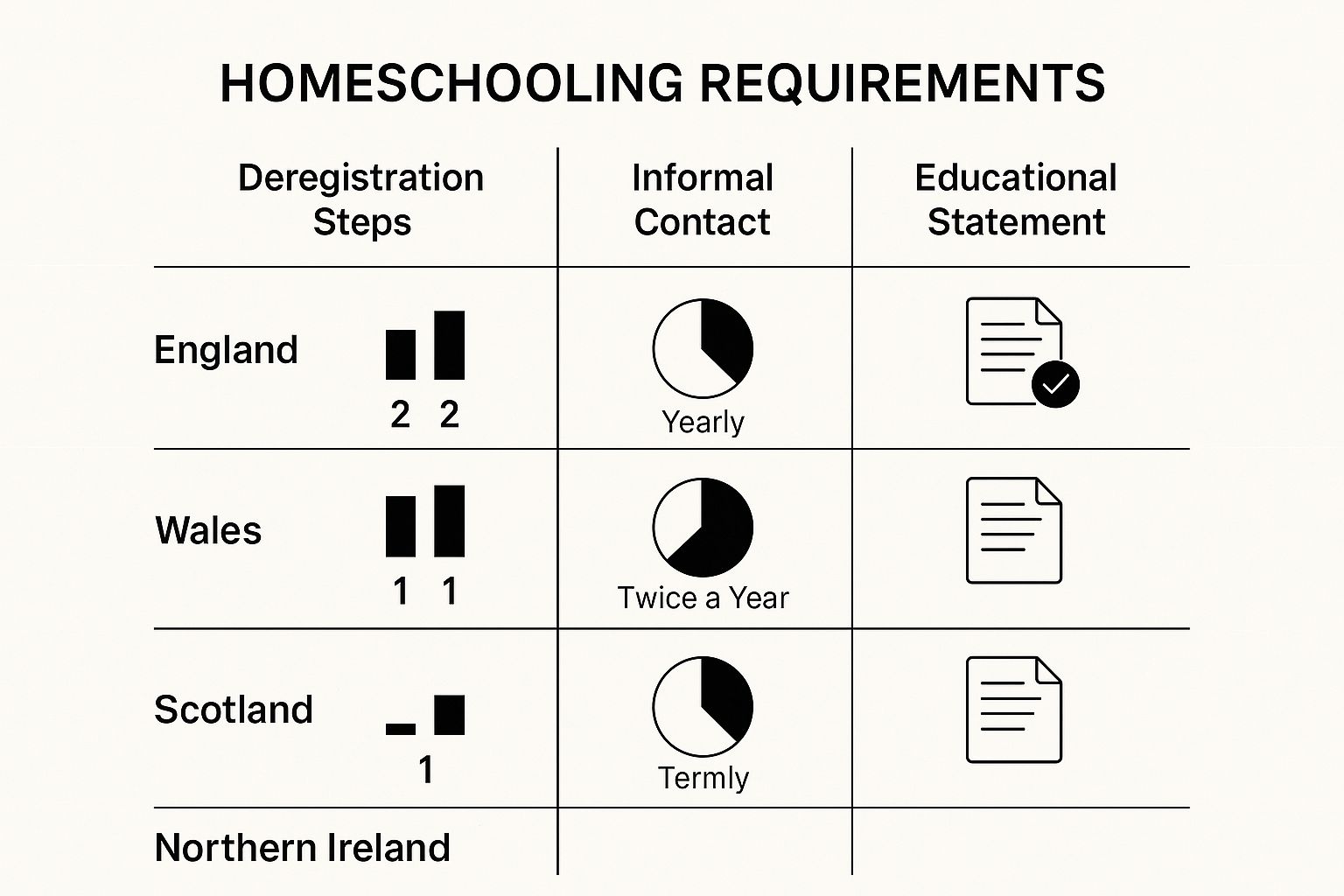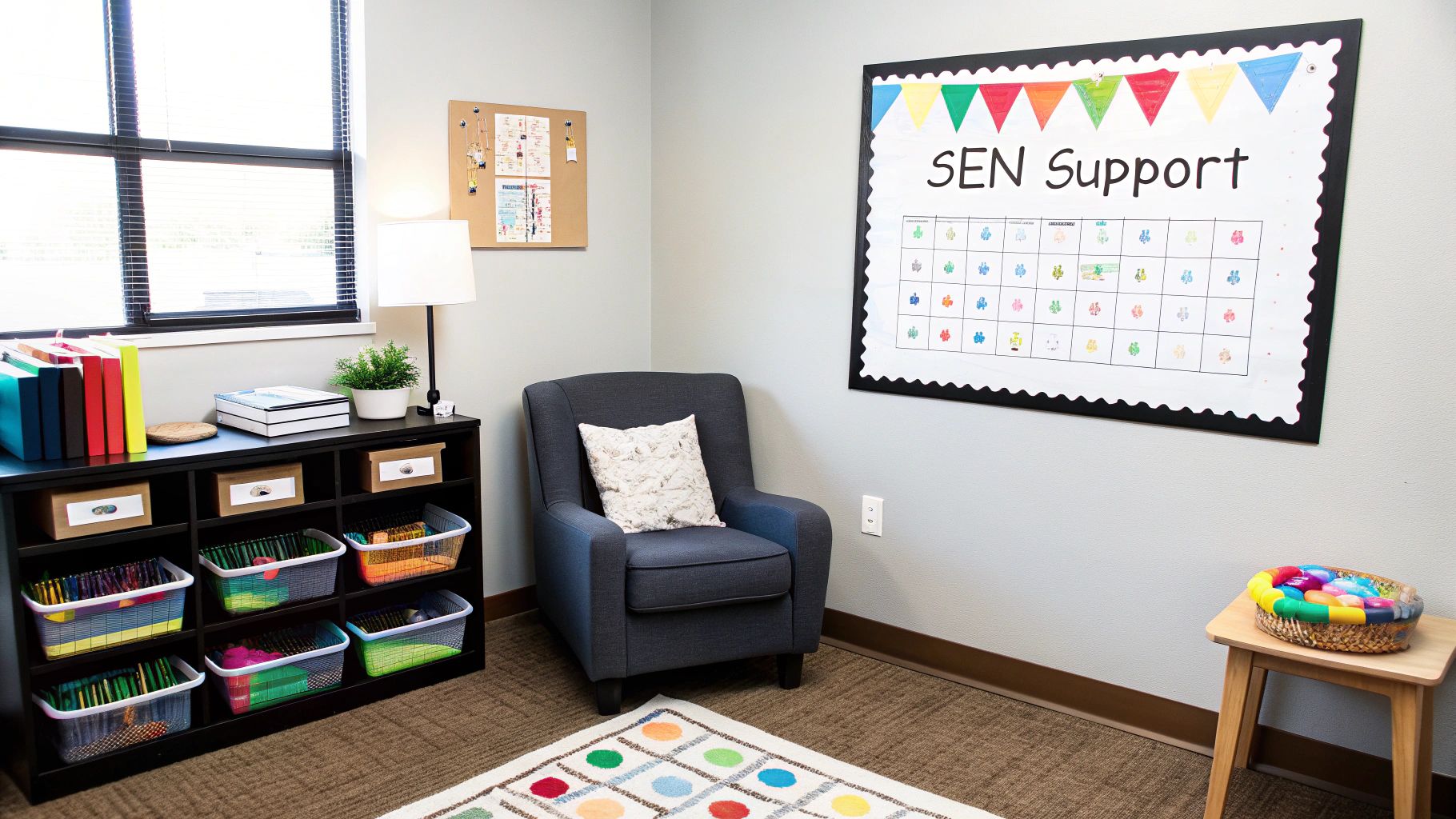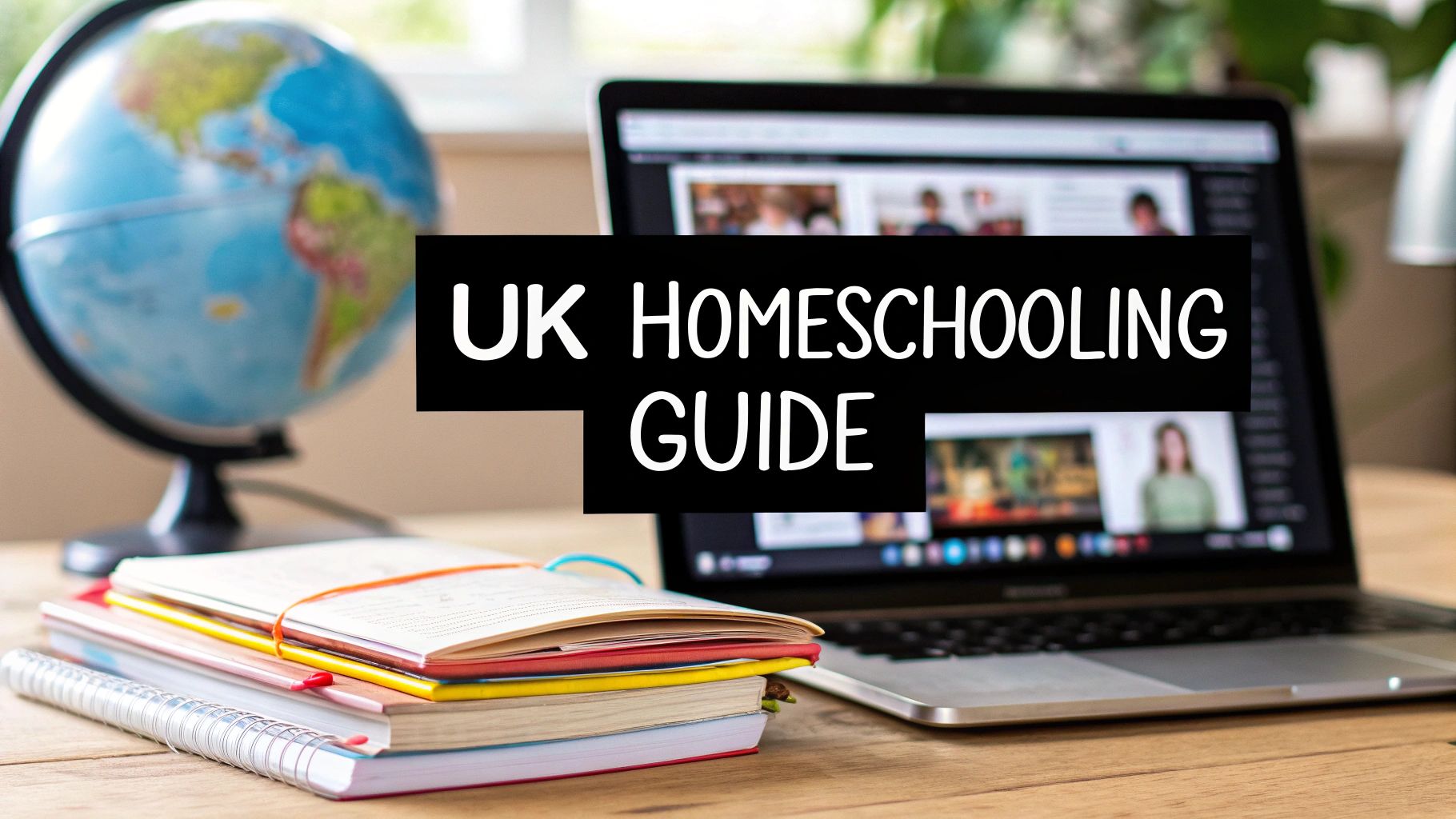Choosing to homeschool your child using the UK curriculum is a powerful decision, one that puts their unique needs right at the heart of their education. It's about stepping away from a one-size-fits-all model and crafting a learning journey that truly fits them. This guide is here to help you turn that heartfelt choice into a confident reality.
Your Homeschooling Journey With The UK Curriculum

The decision to homeschool often comes from a deep, personal place. Maybe you’ve seen your child’s natural spark begin to dim in a busy classroom, or you just know their unique talents need more space to breathe and grow. It’s a feeling that you want more for them—more curiosity, more connection, and an education that builds them up from the inside out.
If you’re feeling this pull towards a different path, you’re far from alone. Homeschooling in the UK has seen a huge surge in recent years. The number of children being home-educated in England jumped from around 34,000 in 2011 to over 62,000 by 2023—that's an increase of nearly 82%. You can explore more insights into this growing trend from the Department for Education.
Embracing a Child-Centred Approach
At its core, homeschooling is all about personalisation. Imagine your son is captivated by ancient history but finds structured writing a real struggle. In a homeschool setting, you can dive headfirst into Roman Britain with documentaries, museum trips, and hands-on projects. Then, you can gently build his writing skills by having him create a journal from the perspective of a Roman soldier. This way, you’re nurturing his passion while supporting his development at the same time.
The greatest gift of homeschooling is the freedom to honour your child’s pace and passions. It’s about creating an environment where learning isn’t just a task, but a joyful exploration tailored to who they are.
This journey means swapping the rigid school bell for a flexible rhythm that actually works for your family. It’s about learning maths through baking, science through walks in the park, and history through stories that truly capture their imagination. A huge part of making this sustainable is figuring out how to make learning fun, as this will have a massive impact on your child's engagement and long-term success.
Ultimately, choosing to homeschool is an act of empowerment. It’s a commitment to providing an education that isn't just "suitable" by law, but is genuinely suitable for your child. This guide will walk you through all the practical steps, from your legal duties to curriculum choices, giving you the confidence to build a thriving learning environment right at home.
Navigating Your Legal Duties With Confidence
Let's be honest, one of the first things that pops into your head when you think about homeschooling is the law. It can feel like a huge, intimidating barrier, sparking all sorts of worries. But getting your head around your legal duties is actually the first, most powerful step you can take toward building a confident and secure homeschooling life for your child.
The legal side of things for homeschooling in the UK is surprisingly straightforward. The core principle is simply that your child has a right to a suitable education. What trips people up is that the small print changes a bit depending on where you live. Each country has its own way of managing things, but the goal is always the same: making sure your child is getting what they need to thrive.
Understanding Your Local Authority
The very idea of dealing with your Local Authority (LA) can cause a lot of anxiety for parents. It’s easy to imagine a formal inspection or being put under a microscope, but the reality is usually a world away from that. Their job isn’t to judge or criticise your choices, but to work alongside you to make sure your child is receiving an education that fits their age, ability, and any special needs they may have.
Try to think of them less as inspectors and more as partners in your child’s educational journey. In England and Wales, for instance, they have a duty to make informal enquiries to satisfy themselves that a suitable education is being provided. This is your chance to show them the wonderful, personalised learning experience you’ve created.
This chart breaks down the key legal differences across the UK, helping you see at a glance what to expect in your neck of the woods.

As you can see, each country strikes a slightly different balance between parental freedom and official oversight, with Scotland requiring upfront consent while England focuses more on checking that the education provided remains suitable over time.
Taking the First Steps: Deregistration and Communication
If your child is currently in a mainstream school, your first practical step is to formally deregister them. This is usually a simple letter, but it’s a crucial one.
- In England and Wales: You just need to write to the school's headteacher stating your intention to home educate. Once the school has your letter, they are required to take your child off the register.
- In Scotland: The process is a little different here. You must ask for permission from your local council to withdraw your child from school. This is usually granted unless there are specific welfare concerns.
- In Northern Ireland: Much like in England, a formal letter to the school principal is generally all you need to start your home education journey.
Once you’ve done this, your LA may get in touch. This is completely normal. Being ready for this call or letter can turn it from something stressful into a positive, constructive conversation. For a much deeper dive into the nuts and bolts, our guide on how to homeschool in the UK gives you step-by-step advice.
Your educational philosophy is simply the "why" behind what you do. It’s a short, heartfelt explanation of how you plan to meet your child's needs through a tailored education that helps them flourish.
Putting together a brief educational philosophy or a simple report on your child's progress can be a game-changer. This doesn’t have to be some stuffy academic paper. Think of it as a simple outline of your approach, the resources you're using, and the fantastic progress your child is making.
Here’s a practical example:
Imagine you have a hands-on learner who was wilting in a traditional classroom. Your statement could say something like: "We're taking a project-based approach centred on Maya's love for nature. This term, we are exploring local ecosystems through woodland walks (Science, Geography), keeping a detailed nature journal (English), and calculating plant growth rates (Maths). This method lets her learn actively and at her own pace, and we've seen a huge boost in her confidence and engagement."
This simple, child-focused explanation clearly shows you’re providing a suitable and thoughtful education. By framing your communication around your child’s needs and successes, you build a constructive and respectful relationship with your LA. Suddenly, those legal duties stop being a source of fear and become the very foundation of your family's homeschooling confidence.
Choosing a UK Curriculum Path for Your Child

This is where the real joy of homeschooling begins. You get to step away from the rigid, one-size-fits-all model and become the architect of your child’s education. It’s all about creating a learning experience that lights them up, respects their individuality, and meets them exactly where they are.
Forget the idea of simply recreating a school classroom at your kitchen table. The true power lies in shaping the homeschooling in UK curriculum to fit your child's unique spirit. You aren't bound by the school bell or a fixed timetable; you have the freedom to build a rhythm that genuinely works for your family.
This freedom allows you to craft an education that feels less like a chore and more like a shared adventure.
Using the National Curriculum as a Guidepost
Many parents find comfort in the structure of the UK National Curriculum, and it’s a brilliant starting point. Think of it not as a strict set of rules, but more like a helpful map or a flexible framework. It outlines the key subjects and general topics children are expected to cover at each Key Stage, ensuring they receive a well-rounded education.
You can use it to guide your long-term goals. For instance, it helps you make sure your child is covering core concepts in English, Maths, and Science in a way that aligns with national expectations. This is especially useful if they might re-enter mainstream school or pursue GCSEs later on.
The key is adaptation. You don’t need to follow it lesson-by-lesson. If the curriculum suggests studying medieval castles, you can bring it to life with a family trip to a real one, build models at home, or write exciting stories about knights and dragons. You are in control of the 'how'.
Exploring Different Educational Philosophies
Beyond the National Curriculum, a world of inspiring educational philosophies can enrich your homeschooling. These aren't rigid systems but guiding principles that can help you create a learning environment that truly resonates with your child.
Choosing the right approach—or blending a few—is all about understanding your child’s natural learning style. To help you decide, here’s a look at some popular philosophies and how they might fit into a UK homeschooling framework.
Comparing UK Homeschooling Curriculum Approaches
| Approach | Core Philosophy | Best Suited For Children Who… | Alignment with UK Curriculum |
|---|---|---|---|
| National Curriculum-Led | Structured, comprehensive coverage of core subjects. | Thrive on routine, may return to mainstream school, or are targeting GCSEs/A-Levels. | Direct Alignment. Provides a clear pathway for all Key Stages and formal qualifications. |
| Charlotte Mason | Education of the "whole child" using rich literature ("living books"), nature study, and art. | Are creative, love stories, and learn best through narrative and hands-on exploration. | Flexible. Can easily cover English, History, and Science topics, though may need supplementing for Maths. |
| Montessori | Child-led, hands-on learning with specially designed materials to foster independence. | Are independent, self-motivated, and enjoy discovering concepts for themselves through practical activity. | Adaptable. Strong for Early Years and Primary Maths/Science concepts. Can be blended for older children. |
| Unschooling | Child-led learning driven by natural curiosity and interests. Learning happens organically through life. | Are highly curious, self-directed, and learn best when following their own passions without formal structure. | Indirect Alignment. Requires careful documentation to show progress if formal qualifications are a future goal. |
Ultimately, no single approach has to be your final choice. Many families find their sweet spot by mixing and matching to create a truly bespoke education that works for them.
The most effective homeschooling path is often a blend. You could follow the National Curriculum for core subjects like Maths while embracing the Charlotte Mason love for nature and great literature for your humanities studies. It’s about creating your own unique tapestry.
This blended approach is where you can truly meet your child’s needs. For a comprehensive overview of how to structure this, our detailed guide on the https://queensonlineschool.com/homeschooling-curriculum-uk/ offers a deeper look into building a bespoke plan.
A Practical Example of a Bespoke Curriculum
Imagine you have a ten-year-old son, Leo. He’s a maths whizz who can spend hours on complex problems, but he finds writing overwhelming and avoids it at all costs. In a traditional school, he might be labelled as "struggling" in English, which could easily damage his confidence.
At home, you can build a curriculum that celebrates his strengths while gently supporting his challenges.
- Lean into His Passion: You can provide advanced maths resources, online courses, and logic puzzles that truly challenge him. He soars, building immense confidence in his abilities.
- Integrate Writing Gently: Instead of forcing essays, you link writing to his interests. He could design a video game and write the character backstories or start a blog where he explains solutions to tricky maths problems.
- Use a Different Approach: You might use a Charlotte Mason approach for English, reading captivating adventure stories aloud together to ignite his imagination without the immediate pressure of writing.
This bespoke model allows Leo to thrive. He sees himself as a capable learner, and his confidence in maths creates a positive foundation for tackling subjects he finds more difficult. When defining your child's UK curriculum path, using comprehensive course outline templates can help you create a clear and organised structure for their studies.
Ultimately, choosing a curriculum path is an act of deep connection. It’s about observing your child, understanding what makes them tick, and building an educational world where they can truly flourish.
Managing Key Stages And Formal Assessments
One of the biggest worries for families new to home education is exams. How do you possibly get from a relaxed, creative learning setup at home to sitting official GCSEs or A-Levels? It can feel like a daunting leap, but it’s an entirely manageable—and often empowering—process with a bit of forward planning.
The trick is to stop thinking about replicating school. Navigating formal qualifications is more about understanding the system and making it work for your family. The UK curriculum is helpfully broken down into Key Stages, which serve as handy signposts. They let you track progress without being shackled to a rigid classroom timetable.
Understanding The Key Stage Journey
Think of the Key Stages as a gentle roadmap for your child's education, not a set of strict deadlines. In a home-learning environment, you have the incredible freedom to move at your child’s pace, making sure they’ve truly grasped a concept before you move on.
- Key Stage 1 (Ages 5-7, Years 1-2): This is all about laying the foundations. It’s like planting a garden; the focus is on nurturing a love for reading, getting comfortable with basic numbers, and exploring the world with curiosity and play.
- Key Stage 2 (Ages 7-11, Years 3-6): Now, the learning gets a little deeper. Your child shifts from learning to read to reading to learn. They’ll get to grips with more complex maths and start properly exploring history, geography, and the sciences.
- Key Stage 3 (Ages 11-14, Years 7-9): This stage is about broadening horizons and setting the scene for more specialised study. It's a vital time for discovering passions that could later become GCSE subjects.
- Key Stage 4 (Ages 14-16, Years 10-11): Here, the focus naturally narrows towards formal qualifications, mainly GCSEs.
For home-educating families, these stages flow seamlessly into one another. There are no abrupt jumps. A passion for Ancient Egypt sparked in KS2 can be cultivated right through KS3, leading to a confident decision to take Classical Civilisation at GCSE.
The Path To GCSEs And A-Levels As A Private Candidate
When your child is ready to pursue qualifications, they’ll do it as a private candidate. This simply means they aren't enrolled at the school where they physically sit their exams. It’s a well-trodden path, and it puts you in complete control.
The whole process boils down to three key steps: picking subjects and exam boards, finding an exam centre, and getting registered.
Taking exams as a private candidate is an act of self-direction. It empowers your child to take ownership of their qualifications, choosing subjects that genuinely reflect their passions and future goals, not just what's available on a school timetable.
Let’s walk through how this might look for a real family.
Meet the Smiths and their son, Tom (14):
Tom is a creative, hands-on learner who loves technology and art. Mainstream school felt restrictive, but at home, he’s absolutely thriving. Now, he wants to take GCSEs to open up his options for college.
Step 1: Choosing Subjects and Exam Boards
The Smiths sit down with Tom to talk about what he truly loves doing. He’s always building things on his computer and is a brilliant artist. They decide on a list:
- Maths and English Language (the core subjects)
- Computer Science
- Art and Design
- History (one of his personal interests)
Next, they need to pick an exam board for each subject—the main ones are AQA, Edexcel (Pearson), and OCR. They research the specifications for Computer Science and discover the AQA course has a practical programming project that’s perfect for Tom's hands-on style. Critically, they check each subject to make sure the specification doesn’t include non-examinable assessment (NEA) components that are impossible to complete outside of a school setting.
Step 2: Finding a Welcoming Exam Centre
This can be the trickiest part of the puzzle. Not every school or college accepts private candidates. The Smiths use online directories and start calling local secondary schools and sixth-form colleges, asking if they’ll accept a private candidate for Tom's specific subjects and exam boards. After a few calls, they find a college 20 miles away that is happy to help. The college is clear about the fees, which cover the admin and invigilation costs.
Step 3: Registering and Preparing
With an exam centre secured, the Smiths register Tom before the official deadline (which is typically in February for summer exams). They buy the right textbooks for the AQA specifications and map out a study schedule that plays to Tom’s strengths, leaving him plenty of time for his programming work. Because the subjects are his choice, he feels motivated and in control of his own future.
Exploring Meaningful Alternatives
Formal exams aren't the right path for every child, and that’s completely okay. The beauty of the homeschooling in UK curriculum is its inherent flexibility. For a child who finds high-stakes exams incredibly stressful, or whose talents are more vocational, there are plenty of other valuable qualifications.
These can include:
- BTECs: Great vocational qualifications that are often more coursework-based.
- Functional Skills: Practical qualifications in English, Maths, and ICT.
- Open University Courses: A fantastic route for older teens to start gaining university credits.
- Creating a Portfolio: A detailed portfolio showcasing work, projects, and experiences can be incredibly powerful, especially for creative fields or apprenticeships.
Ultimately, managing assessments isn't about jumping through hoops. It’s about choosing a path that validates your child's strengths and supports their ambitions, turning what seems like a daunting challenge into a clear, achievable goal.
Creating A Supportive SEN Homeschool Environment

For many families, the move to homeschool is deeply personal. It often comes from a powerful desire to create a true educational sanctuary for a child with Special Educational Needs (SEN). A traditional classroom—with its constant noise, social pressures, and one-size-fits-all pace—can feel like an impossible space for some children.
At home, you have a profound opportunity. You can design a world where your child feels safe, understood, and genuinely able to learn. This isn’t about running from challenges; it’s about meeting them head-on with tailored tools and endless compassion. Homeschooling lets you strip away the sensory overload and anxiety that so often block learning, replacing it with a rhythm that respects your child’s unique needs. It’s a chance for them to finally breathe and flourish.
Designing a Child-First Learning Space
The first step is to see your home through your child’s eyes. What calms them? What triggers their anxiety or overwhelm? A supportive environment is built by carefully curating a space that minimises stress and maximises focus. This is where you can truly adapt the homeschooling in UK curriculum to their sensory and emotional reality.
Think of it as building a bespoke learning nest. For a child with ADHD, this could mean creating a predictable visual timetable for the day, breaking lessons into tiny, manageable chunks with plenty of movement breaks. For an autistic child, it might involve setting up a quiet, low-stimulus corner with comforting textures where they can decompress when the world gets too loud.
Your home's greatest strength is its flexibility. It can become a multi-sensory lab, a quiet reading nook, or an active learning zone—whatever your child needs it to be in that moment. This adaptability is something a school of thirty can rarely offer.
Practical Examples of SEN Adaptations
Putting your child’s needs at the centre means moving beyond generic worksheets and embracing creative, practical solutions. Your deep understanding of your child is your greatest asset in this process.
- For a child with dyslexia: Instead of relying only on written texts, you can bring in audiobooks, speech-to-text software, and coloured overlays. Maths problems can be explained with physical objects, like LEGO bricks, to make abstract concepts concrete and far less intimidating.
- For a child with dyspraxia: You can focus on strengthening fine motor skills through fun, pressure-free activities like pottery, baking, or typing games. Lessons can be recorded so they can just listen and absorb, without the added stress of trying to take notes.
This personalised approach goes beyond pure academics. It's about rebuilding confidence and nurturing a love for learning that may have been damaged in a system that wasn't built for them. When you see your child finally grasp a concept because you explained it in a way that just clicks, the feeling is immeasurable.
Building Your Support Network
While you are the leading expert on your child, you don’t have to do this alone. Creating a supportive SEN homeschool environment means building a team. This often involves collaborating with specialists like educational psychologists, speech therapists, or occupational therapists who can provide targeted strategies to weave into your daily routine.
Connecting with other homeschooling families who truly understand the SEN journey can provide invaluable emotional support and practical advice. Furthermore, specialist online learning providers can be a fantastic resource. Exploring dedicated online courses for SEN students can offer structured, expert-led teaching that complements your home-led efforts, giving both you and your child additional support and resources.
Ultimately, choosing to homeschool your SEN child is a powerful act of advocacy. It's a commitment to providing an education that not only meets their academic needs but also nurtures their emotional wellbeing, building a foundation of confidence and happiness that will last a lifetime.
Building Your Homeschooling Community And Support
Taking on your child's education is a huge act of love, but it’s easy to feel the weight of that responsibility. The good news? You absolutely don’t have to do it alone. A thriving, joyful homeschooling life is rarely a solo mission—it's built on connection, shared wisdom, and a solid support network.
Finding your tribe—other parents who just get it—can change everything. It turns those moments of self-doubt into shared problem-solving sessions and personal wins into group celebrations. This sense of community is just as important for you as it is for your child, giving you both the resilience and practical advice to keep going.
Finding Your Tribe, Online and Locally
First things first, you need to connect with other families who know the unique rhythm of home education. This opens up a world of social opportunities for your child and gives you a space to swap ideas, vent, and learn.
- Local Homeschooling Groups: A quick online search for something like "[Your Town] homeschool group" is the best place to start. You’ll likely find local co-ops and regular meet-ups that can be a real lifeline, organising everything from park days and museum trips to group science experiments.
- Online Forums and Social Media: Platforms like Facebook are buzzing with UK-based homeschooling groups. Many are split by region, educational style, or specific needs (like SEN). These communities are active around the clock, offering a place to ask a quick question at 10 pm or find a brilliant resource you’d never have discovered otherwise.
Imagine the relief of finding another parent navigating the exact same homeschooling in UK curriculum challenges as you. Or the joy your child feels making friends who also learn at their kitchen table. These connections make the whole journey feel less isolated and far more sustainable.
Community is the scaffolding that holds your homeschooling structure together. It provides the strength, flexibility, and encouragement you need to build a confident and happy learning environment.
Weaving in External Support
Building a community also means knowing when to bring in the experts. Think of yourself as the architect of your child’s learning—you design the blueprint, but you can hire brilliant specialists to build certain rooms. This approach lets you play to your strengths while making sure your child gets expert guidance where it counts.
This could mean a local tutor for a subject that’s not your strong suit, a sports club for them to burn off energy, or a drama group to build their confidence. Online schools, in particular, are fantastic for this. They offer structured, expert-led courses that slot neatly into your schedule, taking the pressure off you for those trickier subjects like GCSE sciences or A-Level maths.
A Community-Led Week in Action
So, what does this look like in practice? Let’s imagine a family with an 11-year-old named Chloe. Her parents have created a vibrant week by blending their own teaching with community support:
- Monday & Wednesday: Chloe’s mum leads a hands-on history project about the Tudors, using fantastic books and documentaries (Parent-Led).
- Tuesday Morning: Chloe heads to her local homeschool co-op for a group science lab, working with friends on experiments she couldn't do at home (Peer Learning).
- Tuesday Afternoon & Thursday: She logs into live online classes for Maths and Spanish. They’re taught by a subject-specialist who knows exactly how to prepare her for future qualifications (External Provider).
- Friday: The whole family meets up with their local homeschool group for a long walk and a bit of nature journaling (Social & Community).
This kind of blended approach gives Chloe a rich, well-rounded education. She develops strong friendships and gets top-notch instruction, all while her individual needs remain the absolute priority. By building a diverse support network, you’re not just homeschooling—you’re creating a shared, successful, and truly enjoyable experience.
Common Questions About Homeschooling In The UK
Venturing into the world of homeschooling is a big step, and it’s only natural to have a few questions buzzing around your head. That feeling of uncertainty is completely normal—in fact, it’s a sign you’re taking this seriously. Getting clear, reassuring answers can turn that doubt into confidence, empowering you to make the very best decisions for your child.
Your dedication and unique insight into your child are what matter most, far more than any formal teaching certificate.
Do I Need To Be A Qualified Teacher?
Absolutely not. This is a common myth, but the law is clear: there is no legal requirement in the UK for a homeschooling parent to hold any formal teaching qualifications. The only requirement is that you provide a 'suitable' education that’s right for your child's age, ability, and aptitude.
What truly matters is your commitment, your resourcefulness, and your deep, personal understanding of how your child learns best. You're already their first and most important teacher.
How Will My Child Socialise?
This is probably the question every home-educating parent hears most often, and the answer is wonderfully positive. Socialisation in a homeschooling environment is deliberate and diverse, breaking free from the limits of a single-classroom peer group.
Socialisation isn't about being surrounded by thirty other children of the exact same age. It’s about learning to build genuine connections with people of all ages and backgrounds in real-world settings.
Children have endless opportunities to build fantastic social skills through a whole range of activities:
- Homeschooling Co-ops: Getting together with other families for collaborative lessons in subjects like science or art.
- Local Clubs: Joining sports teams, drama groups, Scouts, or Guides.
- Community Activities: Volunteering, taking part in library events, or learning a musical instrument.
This approach often fosters well-rounded, confident children who are just as comfortable talking to a friend their age as they are to an adult at the local shop.
How Much Does Homeschooling Cost?
The cost of homeschooling with the UK curriculum varies enormously and is completely in your hands. It's entirely possible to provide a brilliant education on a tight budget by making smart use of free resources like local libraries, excellent online materials, and museums.
Of course, costs can go up if you decide to buy structured curricula, hire private tutors, or pay for exam fees for qualifications like GCSEs or A-Levels. The key is that you control the budget.
Ready to build a flexible, supportive, and accredited education for your child? At Queen's Online School, we blend live, expert-led classes with the freedom of home learning, offering a complete British curriculum from Primary right through to A-Levels. Discover how our personalised approach can help your child truly thrive.
Explore our online courses at https://queensonlineschool.com.

